The Chinese Meteorological Society
Article Information
- KE Dan, GUAN Zhaoyong. 2014.
- Variations in Regional Mean Daily Precipitation Extremes and Related Circulation Anomalies over Central China During Boreal Summer
- J. Meteor. Res., 28(4): 524-539
- http://dx.doi.org/10.1007/s13351-014-3246-9
Article History
- Received March 2, 2014;
- in final form June 18, 2014
1. Introduction
An increasing amount of attention has been paidto precipitation extreme events in recent decades. Arecent IPCC report(IPCC, 2012)on climate extremesindicated that the frequency of strong rainfall events and the proportion of intensive rainfall to total rainfallmay increase in many areas of the world under globalwarming. This hypothesis is supported by a number ofprimary studies(Karl and Knight, 1998; Stone et al., 1999; Yamamoto and Sakurai, 1999). The intensity and frequency of rainfall may increase even in regionswhere the total rainfall remains constant or decreases(Buffoni et al., 1999; Groisman et al., 1999; Kunkel et al., 1999; Easterling et al., 2000; Manton et al., 2001). Trends in the frequency of extreme rainfall in Chinadiffer substantially by region and season, while trendsin total annual rainfall depend primarily on trends inthe occurrence of extreme rainfall events(Zou et al., 2009). Regional trends and variations are not necessarily consistent with global trends and variations.
Daily precipitation extremes(DPE)in China typically take place south of 35°N, particularly over themid-low reaches of the Yangtze River, the area immediately south of the Yangtze River(the Jiangnan region), and the southeastern Tibetan Plateau. Regional mean daily precipitation extreme(RMDPE)events, which can persist for longer time, are also relatively frequent over these regions(Wang and Qian, 2009). Research on interdecadal variations in torrential rainfall indicates that the frequency of extremeprecipitation events has decreased significantly in recent decades over North China and the Sichuan basin, but has increased significantly over West China, theYangtze River valley, and coastal areas of SoutheastChina(Zhai et al., 1999a, b; Zhai and Pan, 2003; Bao and Huang, 2006).
Extreme precipitation events take place mainlyduring summer and are generally of short duration. The frequency of such extreme events has increasedover the Yangtze River basin and decreased over northern China in recent decades(Wang and Zhou, 2005). RMDPE events lasting for two days or less are mostcommon over the mid-low reaches of the Yangtze Rivervalley and the Jiangnan region, while RMDPE eventslasting three days or more occur predominantly overthe southeast coast, the southeast Tibetan Plateau, and the western part of the Yun-Gui Plateau(Wang and Qian, 2009). The area impacted by summer floodssouth of the Qinling Mountains-Huai River has increased over the past 50 years. This increase was particularly strong during the 1990s(Wang et al., 2005); however, recent studies indicate slight reductions inthe intensity and frequency of summer DPE eventsover the mid-low reaches of the Yangtze River valleyduring the early 21st century(Zou et al., 2009; He et al., 2013).
Weathers underlying RMDPE events fall largelyinto two classes: rainstorms and floods. It is generallybelieved that many torrential rain events originate asmeso-β weather systems. The physical mechanismsbehind the occurrence and development of these sys-tems are extremely complicated as the systems areheavily localized and develop very rapidly. So far, the scientific underst and ing of meso-β rainstorms isstill not sufficient enough for reliable forecasting(Bei and Zhao, 2002; Wang and Li, 2002; Xu et al., 2008). Many studies have examined the formation mecha-nisms of large-scale droughts and floods, such as theattribution of the 1998 Yangtze basin floods to ENSO(Huang et al., 1998; Sun and Ma, 2001) and baroclinic wave activity at upper levels(Mei and Guan, 2009). Most studies on RMDPE have focused on thelong-term trends or small-scale events(Guan and Ren, 2012); relatively few studies have examined RMDPEevents with regional or large-scale coverage(Guan et al., 2011).
Central China is one of the most important regionwith dense population and quick economical development. This region is located to the east of the TibetanPlateau, where cold air from the north and warm airfrom the south converge at lower levels. RMDPEevents can cause severe flooding in central China, withserious impacts on industrial activity, agricultural productivity, and daily lives of the human population. Torrential rain events that occur at low frequency butwith high intensity and long duration are very likely toproduce large-scale floods(Xiao et al., 2010). Examples include the 4-day rainstorm over Lake Dongtingvalley in July 1996(Zhang et al., 2004), the 10-dayrain event over the Jiangnan region in June 1998(National Climate Center, 1998), and the 9-day rain eventover the mid-lower Yangtze basin in June 1999(Zhang et al., 2001). All of these rain events had serious socioeconomic consequences.
Central China covers an extensive area in thenorth-south direction with complex topography and climate regime. Scientists in each of the threeprovinces(Henan, Hubei, and Hunan)of central Chinahave conducted studies on the characteristics of rainfall in their own provinces(Qin and Wang, 1997; Jiao and Kang, 2007; Zhang et al., 2008) and in centralChina as a whole(Chen et al., 2010; Sun et al., 2010; Ren et al., 2013). The exceptional flood that occurredin the Yangtze River basin in 1998 was investigated bymany research groups(e. g., Huang et al., 1998; Ren et al., 2000; Mei and Guan, 2009), demonstrating somecomplicated features in circulation anomalies relatedto both the anomalous sea surface temperature in thetropics and the Rossby wave activities in midlatitudes. Guan et al. (2011)showed that different patterns ofPacific sea surface temperature anomalies(SSTA)arelikely to have a considerable influence on the occur-rence of RMDPE events in the Yangtze River basin. However, little efforts have been made to identify and attribute the causes of regional rainfall extremes overcentral China. Therefore, we examine in the presentpaper the variations of summertime RMDPE eventsover central China during 1961-2010 using in situ pre-cipitation observations from 239 stations and daily me-teorological data from the NCEP/NCAR reanalysis. The results that explore the features and causes ofsummer RMDPE events over central China will helpto advance our underst and ing of the mechanisms ofweather and climate variations in this region and toimprove disaster prevention and mitigation efforts. 2. Data and methods2. 1 Data
This work is based on daily rainfall observationsfrom 239 stations within central China between 1961 and 2010, as well as historical records from the archivesof Henan, Hubei, and Hunan provinces. Of the 239stations with complete data records between 1961 and 2010, 97 are located in Henan, 67 in Hubei, and 75 in Hunan. Meteorological variables and relatedphysical quantities are taken from the NCEP/NCARdaily reanalysis(Kistler et al., 2001)at a horizon-tal resolution of 2. 5° × 2. 5°. Typhoons over centralChina are identified using the Optimal Tropical Cy-clone Paths Atlas released by the China Meteorolog-ical Administration(CMA)(http://tcdata. typhoon. gov. cn/zjljsjj-zlhq. html). Summer comprises June, July, and August(JJA). 2. 2 Methods
A number of techniques for testing the homogeneity of rainfall data have been developed in recent years, including the st and ard normal homogeneity technique(SNHT) and the Buish and method. SNHT is a parameter verification technique for judging the inhomogeneity of a time series against a reference time se-ries, and can be used to detect sudden shifts or lineartrends(Hawkins, 1977; Li et al., 2008). The Buish and method is based on the sum of departures fromthe mean of the time series(Wijngaard et al., 2003). We also use a two-term regression(Solow, 1987), thePettitt scheme(Pettitt, 1979), and multivariate linearregression to analyze the precipitation data. Thesefive tests are used as the criteria for selecting statistically significant station data at the 99% confidencelevel. Stations with annual total rainfall time seriesthat pass at least three of the five statistical tests areselected for further study. These criteria are met for233 of the 239 stations.
The stations in central China that meet our selection criteria are distributed densely and approximatelyhomogeneously. We therefore use a simple arithmeticaverage to represent the regional mean:
where Pri denotes daily mean rainfall at the ith station. We investigate the causes of RMDPE events bycomputing vertically integrated water vapor fluxes, ap-parent heat sources, and apparent water vapor sinks. Water vapor fluxes are calculated aswhere q is specific humidity, ps is surface pressure, and V is the horizontal wind vector. The apparent heatsource Q1 and the apparent vapor sink Q2 are calcu-lated aswhere g is gravitational acceleration, L is the latentheat of condensation, Pr is rainfall, E is the evapo-ration rate of cloud droplets in the air column, C isthe generation of liquid water via water vapor conden-sation in the air column(excluding raindrops), LEsis the surface latent heat flux, pt is the pressure atthe top of the troposphere(set to 300 hPa), Qs is thesurface sensible heat flux and hQri is the vertical integral of radiative heating or cooling.Takaya and Nakamura(2001)derived a wave activity flux for migratory and stationary Rossby wavesrelative to the background flow and independent ofwave phase. This wave activity flux can be used to diagnose the propagation of wave energy. The horizontalcomponent is calculated in pressure coordinates, and has the form
where U is the background flow(U = Ui + V j), CUis the phase speed relative to the background flow(CU = CPU/|U|), W is the wave activity flux(TNfluxes hereafter)parallel to the group speed, Wr isthe wave disturbance energy flux excluding CUM, Mis the wave-activity pseudomomentum, and ψ' is thequasi-geostrophic perturbation stream function. Waveactivity intensifies in locations where the wave activ-ity fluxWr converges, and weakens in locations whereWr diverges. 3. General characteristics of summer rainfallover central ChinaThe general features of annual and summer precipitation in central China provide necessary contextfor studying summer RMDPE episodes. Figure 1 shows maps of the 50-yr climatological annual mean and summer mean rainfall and the fractional contribution(%)of summer precipitation to total precipitation. Annual mean precipitation decreases progressively from south to north over this region. The areas south of the Yangtze River receive greater than1000 mm of rainfall per year, while much of the areas north of the Yangtze River receive less than 1000mm. The latitudinal variation of summer precipitation is less clear. The maximum summer precipitation(> 650 mm)is located at Enshi, Hubei Province.
 |
| Fig. 1. Climatological mean(a)annual and (b)summer precipitation(mm)over central China during 1961-2010 and (c)the fraction in percentage of total precipitation that occurs during summer. Black dots in(a)indicate the locationsof the meteorological stations used in this study . |
Summer rainfall accounts for more than 50% ofthe total precipitation over much of Henan and morethan 40% over most parts of Hubei, but only about 30% over central-southern Hunan. The spatial distribution of the ratio of summer to annual mean precipitation is approximately opposite to the spatial distribution of annual mean precipitation, with a northwardincrease in the relative contribution of summer rainfall.
Figure 2 shows the spatial distributions of maximum daily rainfall. The maximum daily rainfall during summer was 755. 1 mm on 7 August 1975 in Shangcai, Henan. This county is located in the northern partof central China, and the daily mean precipitation overthe past 50 years at this location was relatively low. Infact, this record daily rainfall approached the annualmean precipitation at this station(874. 4 mm). Thisrainfall event can be attributed to the direct effects ofTyphoon No. 7503.
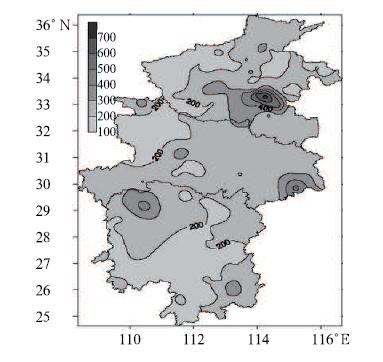 |
| Fig. 2. Maximum single-day summer rainfall(mm)during 1961-2010. |
Precipitation in central China varies on multipletimescales. Figure 3 shows interannual variations inthe relative anomalies of annual and summer precipitation over central China relative to the 1961-2010climatological means. No trends are apparent in therelative anomaly of annual mean rainfall; however, these anomalies do vary on interannual and decadaltimescales. Years of high and low rainfall tended toalternate. On the decadal scale, less rainfall occurredover central China before the 1990s, followed by aperiod of relatively plentiful rainfall that lasted until 2004. Rainfall was relatively scarce during 2005-2010. In contrast to annual rainfall, summer rainfallhas increased over the past 50 years at a rate of 15. 9mm decade-1(significant at the 0. 05 level based onStudent's t-test). Summer rainfall was relatively lowduring the 1960s and early 1970s, high during the late1970s and early 1980s, low from the mid 1980s until the early 1990s, and high during the following 20years. This result is consistent with the conclusions ofprevious studies of abrupt changes in summer precipitation over central China, particularly with respect tothe differences in the variability of annual and seasonalrainfall and the abrupt increase in precipitation thatoccurred between the end of the 1980s and the early1990s(Sun et al., 2010).
 |
| Fig. 3. Anomalies in the ratio(%)of(a)annual and (b)summer precipitation(mm)over central China relative to the1961-2010 climatological means. |
The spatial patterns of climatological annual and summer precipitation are vastly different(Fig. 1). Theinterannual and decadal variability of summer rainfallanomalies over central China also differs from the variability of annual rainfall anomalies(Fig. 3). In particular, summer rainfall has increased significantly. Nosimilar trends can be identified in annual rainfall. 4. Definition and characteristics of summerRMDPE events in central China
By definition, RMDPE events are small probability episodes for each station where they occur. Urbanfloods are possible when extreme precipitation eventsoccur at even one station; however, RMDPE eventstypically occur on regional scales, so they affect multiple stations simultaneously. Ground and river waterlevels can rise substantially over a very short time, potentially resulting in large-scale natural disasters(Guan et al., 2011). We define RMDPE events as thoseevents with regional mean daily rainfall exceeding aparticular percentile relative to the long-term time series of rainfall amount. 4. 1 Definition of RMDPE events
In total, the summers(JJA)of 1961-2010 comprise 4600 days. Mean rainfall over central China exceeded 1 mm on 3458 of these 4600 days. We constructa time series of rainfall amount using these 3458 samples. The 99th percentile of regional mean daily rainfall amount based on this time series is 23. 585 mm. We use this 99th percentile value as the criterion forselecting the summer RMDPE events in central China. A total of 35 events meet this criterion(Table 1). Asubset of these 35 events are described in more detailin Appendix I.
 |
RMDPE events in central China varied on interdecadal timescales during the analysis period. Figure 4a shows the frequency of RMDPE events by year. Three RMDPE events occurred during each year of1969, 1975, 1996, and 2004, but no RMDPE events occurred between 1976 and 1983. RMDPE events haveoccurred relatively frequently since 2002.
 |
| Fig. 4. Occurrence frequencies of RMDPE events in central China during 1961-2010 by(a)year and (b)10-day periodsduring summer(from early June to late August). |
Figure 4b shows the occurrence of RMDPE eventsat 10-day intervals during summer. RMDPE eventswere most frequent during mid July(9 events), whileno episodes took place during mid June. These resultsindicate that the likelihood of an RMDPE event increase substantially from mid June to mid July. Thisincrease in likelihood is consistent with the seasonaldevelopment of the Meiyu rain b and . 4. 3 Spatial distribution
The mean daily rainfall averaged over the 35RMDPE events is much larger than the climatological mean daily rainfall during summer. The largestamounts of precipitation associated with RMDPEevents occurred, in order, over southwestern LuohePrefecture in Henan, the Tangbai River catchmentarea in Henan, and Xiaogan County in northeastern Hubei. The intensity of rainfall during RMDPEevents exceeded 60 mm day-1 over these three locations(Fig. 5a). The spatial pattern of differences be-tween the mean daily rainfall during the 35 RMDPEevents and the climatological mean daily rainfall during summer(Fig. 5b)is largely consistent with thespatial pattern of the daily mean during the RMDPEevents. The mean daily rainfall associated with the35 RMDPE events is generally greater than the climatological mean daily rainfall during summer, with theexception of a small area in southern Hunan. The spatial pattern of the fractional contribution of RMDPEevents to total summer rainfall(Fig. 5c)is also similarto the mean daily rainfall during the RMDPE events. RMDPE days are only 1% of the total number of days, but account for more than 10% of the total summerrainfall in central Henan.
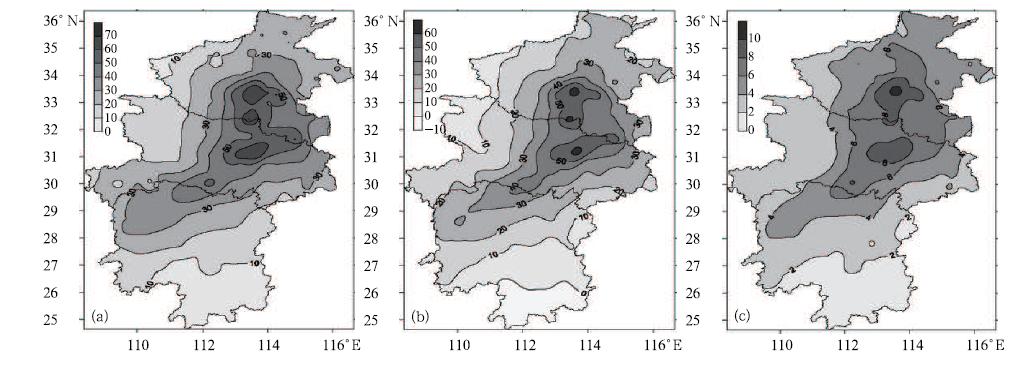 |
| Fig. 5. (a)Mean daily rainfall(mm)during the 35 RMDPE events, (b)differences(mm)between mean daily rainfallduring RMDPE events and the climatological mean, and (c)fractional contribution(%)of RMDPE events to totalsummer rainfall during 1961-2010. |
Summertime RMDPE events are of regional scale and are typically associated with persistent large-scaleprecipitation. These events are therefore relativelylikely to result in flooding, especially in the mountainous areas of central China. We provide a partialdescription of the disastrous consequences of these 35RMDPE events in Appendix I. 5. Circulation anomalies associated with summer RMDPE events
The occurrence of regional RMDPE events maybe attributed to local circulation anomalies. Analysis of the 35 RMDPE events relative to the strongestsingle-day summertime precipitation event(Fig. 2)shows that the catastrophic rainstorm over Henan during 5-7 August 1975 was directly related to TyphoonNo. 7503. Rainfall of this intensity and its impactsoccurred only once in central China between 1961 and 2010. A number of previous studies have examinedthe causes and circulation patterns associated withthis event(Research Team of the 1975 August Rainstorm, 1977a, b; Ding et al., 1978; Beijing Cooperative Research Group for "75. 8" Heavy Rain, 1979; Tan and Chen, 2008). Considering that this typhoon influenced RMDPE event(counted as three RMDDEevents in Table 1)was a special case, we focus ouranalysis on the other 32 RMDPE events(excluding 5-7 August 1975). The spatiotemporal characteristics ofthese 32 events are shown in Appendix II for reference. 5. 1 Circulation patterns
RMDPE episodes occur under the control of local circulation anomalies. Figure 6 shows the difference between the mean circulation composited over the32 RMDPEs and the summer climatology(RMDPEminus climatology). RMDPE events were associatedwith robust cyclonic circulation anomalies in the middle and lower troposphere over central China(Figs. 6a and 6b), centered near 35°N. Southwesterly anomalies to the south favored a deepening of the troughover central China. Anomalous anticyclones occurredover Mongolia and Siberia in higher latitudes, and theSouth China Sea(SCS) and Northwest Pacific at lowerlatitudes. The northern anticyclonic anomaly steeredcold air southward, while the southwesterly flow associated with the low-latitude anticyclonic steered warm and moist air northward. These two flows acted together to produce strong rainfall over central China. The composite circulation in the upper troposphere(Fig. 6c)featured an anomalous anticyclone to thenorth of Lake Baikal and a robust anomalous cycloneover northwestern China. The South Asian high wasexpected to be weaker than normal. These anomaliesenhanced the eastward zonal flow in the upper troposphere over central China. This zonal flow was locatedbetween the outer flows of the cyclonic anomaly tothe north and the anomalous anticyclonic flow to thesouth, and acted to enhance upper tropospheric divergence over central China. The upper troposphericcyclone over the western North Pacific shifted substantially eastward of Japan. The circulation over centralChina was therefore baroclinic, and favored the genesis and maintenance of cloudbursts.
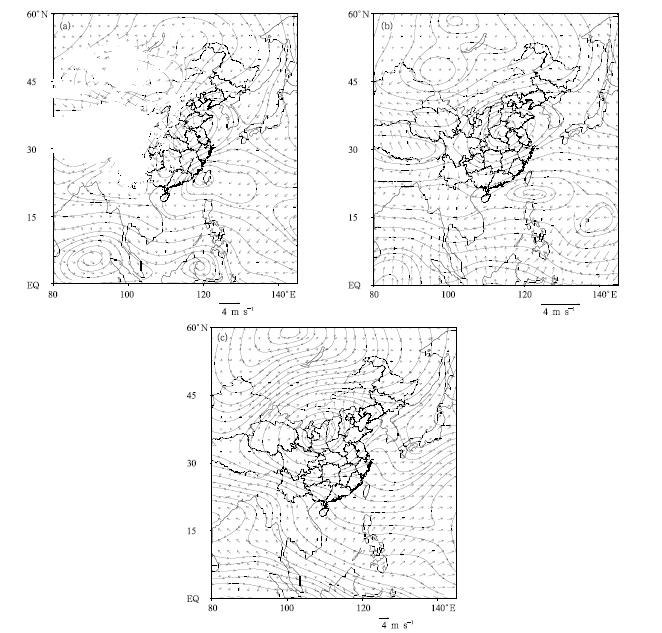 |
| Fig. 6. Mean composite anomalies of rotational(stream lines) and divergent(vectors)wind components(m s-1)at(a)850, (b)500, and (c)200 hPa for the 32 RMDPE events relative to the summertime climatological mean circulationduring 1961-2010. |
Composite anomalies in the divergent componentof the horizontal wind also facilitated the occurrenceof RMDPE events. Convergence was anomalouslystrong in the lower and middle troposphere over central China, while divergence was anomalously strongover the region northwest of central China. Divergencewas anomalously strong in the upper troposphere overcentral China, consistent with both the cyclonic circulation to the northwest and the anticyclonic flow tothe south.
Anticyclone-cyclone-anticyclone anomalies wereprevalent from the northwest to the southeast at different levels in the troposphere. This sequence of anomalies may be evidence of wave disturbances propagatingfrom the midlatitudes. 5. 2 Vertically integrated water vapor fluxes
Abnormal water vapor transport facilitated thegenesis of RMDPE episodes. Figure 7 shows watervapor fluxes integrated from the surface to 300 hPa. During RMDPE events, water vapor entered centralChina through the outer region of the anomalous anticyclones over the Bay of Bengal and SCS in a steppedmanner. Differences in mean water vapor flux divergence between RMDPE composite and the 1961-2010climatology show decreases in water vapor flux divergence over central China and the area to the east ofcentral China. By contrast, water vapor flux divergence was anomalously high over Shaanxi Province and southern China. Anomalously high water vapor flux convergence over central China evidently provided enough water vapor to facilitate the occurrenceof RMDPE events.
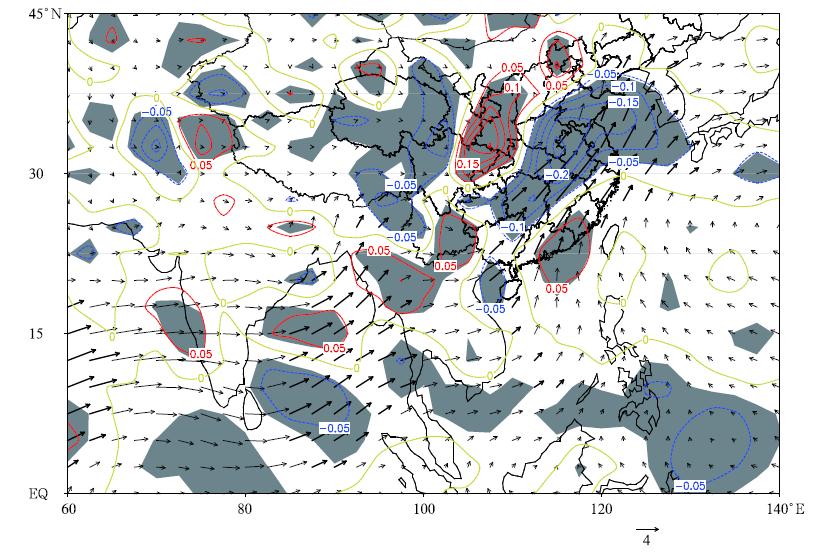 |
| Fig. 7. Composite anomalies of the stream function(kg m-1s-1; vectors) and divergence(kg m-2s-1; solid lines)of the vertically integrated water vapor flux during the 32 RMDPE events. Bold arrows indicate vapor fluxes for whichboth zonal and meridional components are greater than 100 kg m-1s-1. Grey shaded areas indicate values of watervapor flux divergence that are significant at the 99% confidence level using Student's t-test. |
Wave activity fluxes depict the direction of waveenergy propagation. Figure 8 shows the horizontalcomponent and divergence of TN fluxes(excludingCUM; see Eqs. (6) and (7))in the middle and upper troposphere. Mei and Guan(2008, 2009)studied upper tropospheric baroclinic wave activity overthe mid-lower Yangtze River valley during the Meiyuperiod of 1998 and over the Jiang-Huai River valley during the Meiyu period of 2003. They reportedthat baroclinic waves organize into a wave packet thatmoves downstream, carrying disturbance energy thatcan accumulate to support the genesis and development of localized rainstorms. Without considerationof CUM, perturbation energy from the northeasternTibetan Plateau and Hexi Corridor converged overcentral China(Fig. 8). The accumulation of energyover central China favored the development and maintenance of disturbances in central China, and promoted the occurrence of RMDPE events. Park and Schubert(1997)suggested that the 1994 severe summer drought over eastern Asia might have been associated with interactions between atmospheric disturbances and the topography of the Tibetan Plateau. Figure 8 shows that wave energy fluxes emerged atthe northern and northeastern boundaries of the Tibetan Plateau, suggesting that the enhancement and eastward propagation of these disturbances are likelyto be linked to the effects of complex terrain.
 |
| Fig. 8. Wave activity flux(m2s-2; arrows) and wave activity flux divergence(10-6m s-2; shading)as derived fromcomposites of anomalous rotational winds, and summertime mean geopotential height(dgpm; solid lines)at(a)500 and (b)200 hPa. Dark shading indicates wave activity flux divergence greater than 5 × 10-6m s-2, while light shadingindicates wave activity flux divergence less than -5 × 10-6m s-2. The thick solid curve denotes the Tibetan Plateau. |
Figure 9 shows composite anomalies in apparent heat source and apparent water vapor sink forRMDPE events relative to the summer climatologicalmean. The spatial distributions and orders of magnitude of these two variables are largely consistent. The largest values are located over eastern and central China, where the apparent heat source is approximately 500 W m-2 and the apparent water vapor sinkis approximately 400 W m-2. As the surface sensibleheat and evaporative fluxes are typically very smallduring rainstorms(Wang et al., 2008), these maximaare primarily due to condensational heating associatedwith strong convective precipitation(e. g., Guan et al., 2011; Song et al., 2011). Note that the heat source and water vapor sink are both negative over northwesternChina, and the heat source is also negative over thewestern North Pacific and the SCS(with absolute values of approximately 400 W m-2), suggesting that theheating and cooling contrast from the region northeast of Tibetan Plateau southeastward to the Taiwanregion may play a certain role in the occurrences ofRMDPE over central China.
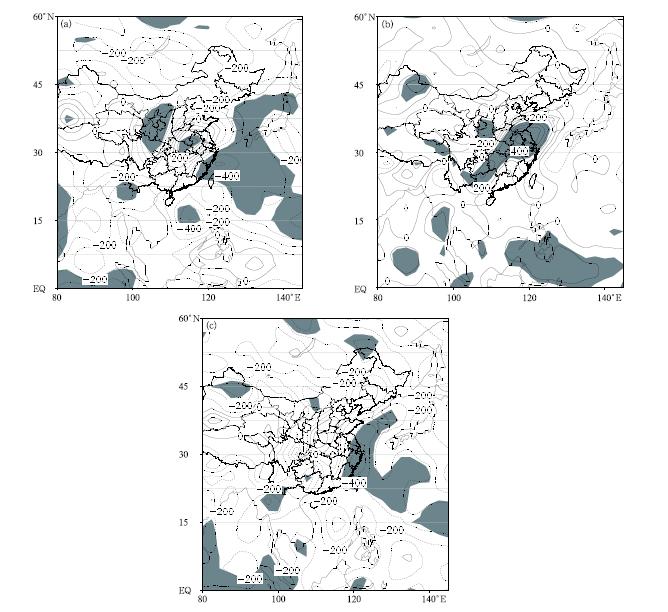 |
| Fig. 9. Composite anomalies of vertically-integrated(a)apparent heat sources < Q1>, (b)apparent water vapor sinks< Q2>, and (c)differences between the two(< Q1>- < Q2>)during the 32 RMDPE events relative to the summertimeclimatological mean during 1961-2010. All data are in unit of W m-2. Shaded areas indicate values that are significantat the 99% confidence level based on Student's t-test. |
The difference < Q1> - < Q2> indicates the portionof diabatic heating not due to condensation of watervapor. Figure 9c shows composite anomalies of thisquantity for the 32 RMDPE events relative to the summertime climatological mean. Small values indicatethat latent heating due to condensation plays a dominant role in the local heat budget. Positive valuesindicate radiative heating and /or heating by the surface sensible or latent heat flux, while negative values indicate radiative cooling and /or cooling by thesurface sensible or latent heat flux(Han et al., 2012). Anomalies of < Q1>-< Q2> associated with RMDPE arepositive in the western part of central China, whichindicates that rainfall associated with RMDPE eventswas stronger over the eastern part of central China. Anomalies of < Q1> - < Q2> are negative over the region south of central China and the coastal regions. Negative values of hq1i - < Q2> suppressed air-columnheating and associated upward motion; however, negative values of < Q1> - < Q2> over the Bay of Bengal, SCS, and western North Pacific promoted lower tropospheric divergence and enhanced water vapor convergence over central China. Han et al. (2012)examined summertime RMDPE over the mid-lower reachesof the Yangtze River valley. They found that anticy-clonic anomalies tend to develop to the northwest ofthe regions of diabatic cooling. The genesis of theseanticyclonic anomalies excites wave trains travelingtoward the north and east, and provides large-scaledisturbances that could promote the development ofRMDPE events. No distinct wave trains propagating northeastward from the SCS are apparent in Fig. 6. Nevertheless, the horizontal gradient in diabaticheating is extremely beneficial to the production and maintenance of ascending motion over central China, furnishing a necessary condition for RMDPE episodes. 6. Concluding remarks
We have performed a composite analysis of regional mean daily precipitation extreme(RMDPE)events during 1961-2010. The conclusions are as follows.
The pattern of annual mean rainfall averagedover central China exhibits a pronounced dependenceon latitude(decreasing from south to north) and significant interannual variations, but with no apparentlong-term trend. By contrast, the 1961-2010 summermean precipitation has increased at a rate of 15. 9 mmper decade and has a very different spatial distribution, with a maximum of more than 650 mm centeredat Enshi, Hubei Province. The fractional contribution of summer rainfall to total annual precipitationincreases from south to north.
The 99th percentile of regional mean daily precipitation between 1961 and 2010 was 23. 585 mm day-1. The occurrence frequency of RMDPE events(definedas daily precipitation exceeding the 99th percentile)varied substantially on interannual and interdecadaltimescales, with a marked increase after the mid 1980s. RMDPE events occurred more frequently between lateJune and mid July.
The genesis and maintenance of RMDPE eventswere associated with robust cyclonic circulationanomalies in the lower and middle troposphere overcentral China. The composite upper-level flow overcentral China was more zonal than normal duringRMDPE events, which promoted upper-level divergence. Anomalous convergence in the lower and middle troposphere over central China reflected enhanced flow from the western North Pacific. Thebaroclinic structure of the anomalous troposphericcirculation promoted the formation and maintenanceof the RMDPE events. Water vapor converged overcentral China in a stepped fashion via the outer regions of the anomalous low-level anticyclones over theBay of Bengal and the SCS. RMDPE events wereassociated with anomalous water vapor convergenceover central China and the areas to the east, and anomalous water vapor divergence over Shaanxi and southern China. Strong water vapor convergence overcentral China also favored the development and maintenance of RMDPE events.
The circulation anomalies associated withRMDPE events were connected to wave disturbances and atmospheric heating anomalies. RMDPE eventsover central China were associated with the eastwardpropagation of Rossby wave disturbance energy fromthe northeastern Tibetan Plateau. These wave disturbances appeared to be caused by the complex terrainin this region. Anomalies in the apparent heat source and water vapor sink associated with RMDPE eventswere positive over central China and negative(orsmall)over the surrounding areas. Diabatic heatinganomalies due to processes other than condensationwere positive over the western part of central China and negative over surrounding areas. The resultinggradient in diabatic heating anomalies promoted ascending motion over central China.
Rossby wave energy in this region appearedto originate mainly over the northeastern TibetanPlateau and propagated eastward(Fig. 8). Thisfeature suggests that topographic effects may playan important role in the genesis and maintenance ofRMDPE events over central China, particularly withrespect to the high topography over Lanzhou and theassociated baroclinic circulation in the middle and upper troposphere. The magnitude of this role remainsto be revealed in future. Appendix I*
Central China suffered a number of severe disasters associated with RMDPE events between 1961 and 2010(Wen and Pang, 2005; Wen and Zeng, 2006; Wen and Jiang, 2007; China Meteorological Administration, 2008, 2009, 2010). This appendix describesthe serious consequences of selected RMDPE events. For detailed description of those events and associateddamage statistics, refer to the Chinese version of thispaper(doi: 10. 11676/qxxb2014. 037). Appendix II
Figure A shows the spatiotemporal patternsof rainfall for 32 RMDPE events, excluding the threedays of Typhoon No. 7503. Comparison with Fig. 4 shows that the three episodes in August 1975 are dueto the passage of the typhoon. This extends the breakwithout summertime RMDPE events to 1975-1983(atotal of 9 yr), and reduces the frequency of RMDPEevents in early August to two.
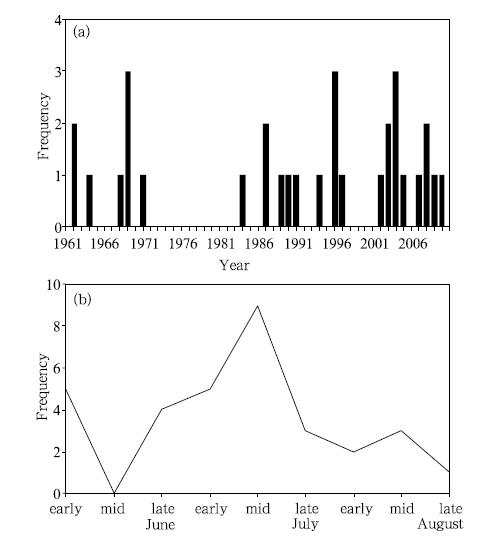 |
| Fig. A. Occurrence frequencies of summertime RMDPEevents in central China during 1961-2010 excluding thethree days of Typhoon No. 7503 by(a)year and (b)10-day interv als during JJA(from early June to late August). |
The spatial distribution of mean daily rainfall av-eraged over these 32 RMDPE events(Fig. B)showsno significant change relative to that averaged over all35 RMDPE events(Fig. 5a). Excluding the typhoonreduces the area of the maximum, with drops in me and aily rainfall over Henan and the emergence of a newlocal maximum(74. 3 mm)in Anlu, Xiaogan, Hubei.
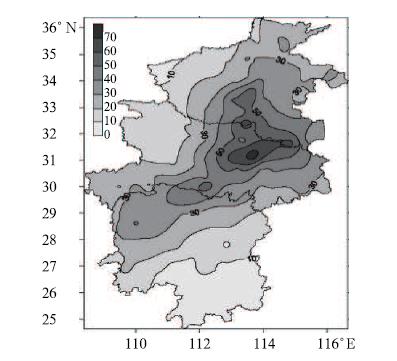 |
| Fig. B. Daily rainfall(mm)averaged over 32 summerRMDPE events in central China(excluding Typhoon No. 7503)during 1961-2010. |
Acknowledgments: We are grateful to WuhanRegional Climate Center for providing station rain-fall data and records of central China meteorologicaldisasters. The NOAA-CIRES Climate DiagnosticsCenter provided the reanalysis data(http://www. cdc. noaa. gov). All graphs were made using the Grid Anal-ysis and Display System(GrADS).
| [1] | Bao Ming and Huang Ronghui, 2006: Characteristics of the interdecadal variations of heavy rain over China in the last 40 years. Chinese J. Atmos. Sci., 30, 1057-1067. (in Chinese) |
| [2] | Data given for some RMDPE episodes during 1961-2000 are taken from the compiled Henan, Hubei, and Hunan Volumes of the Yearly Book of Meteorological Disasters in China, the 2001-2007 data are from the Regional Meteorological Center at Wuhan, and the 2008-2010 statistics is from the Chinese Yearly Book for Meteorological Disasters. Beijing Cooperative Research Group for “75.8” Heavy Rain, 1979: A diagnostic analysis about the “75. 8” heavy rain in Henan. Acta Meteor. Sinica, 37, 45-55. (in Chinese) |
| [3] | Bei Naifang and Zhao Sixiong, 2002: Mesoscale analysis of severe local heavy rainfall during the second stage of the 1998 Meiyu season. Chinese J. Atmos. Sci., 26, 526-540. (in Chinese) |
| [4] | Buffoni, L., M. Maugeri, and T. Nanni, 1999: Precip-itation in Italy from 1833 to 1996. Theor. Appl. Climatol., 63, 33-40. |
| [5] | Chen Bo, Shi Ruiqin, and Chen Zhenghong, 2010: The variation tendency of heavy precipitation events in different grades during recent 45 years over central China. J. Appl. Meteor. Sci., 21, 47-54. (in Chi-nese) |
| [5] | China Meteorological Administration, 2008: Yearbook of Meteorological Disasters in China (2008). China Meteorological Press, Beijing, 233 pp. (in Chinese) |
| [6] | —-, 2009: Yearbook of Meteorological Disasters in China (2009). China Meteorological Press, Beijing, 203 pp. (in Chinese) |
| [7] | —-, 2010: Yearbook of Meteorological Disasters in China (2010). China Meteorological Press, Beijing, 221 pp. (in Chinese) |
| [8] | Ding Yihui, Cai Zeyi, and Li Jishun, 1978: The excep-tional torrential rain event in early August of 1975 over Henan. Chinese J. Atmos. Sci., 2, 276-298. (in Chinese) |
| [9] | Easterling, D. R., J. L. Evans, P. Y. Groisman, et al., 2000: Observed variability and trends in extreme climate events: A brief review. Bull. Amer. Me-teor. Soc., 81, 417-425. |
| [10] | Groisman, P. Y., T. R. Karl, D. R. Easterling, et al., 1999: Changes in the probability of heavy precip-itation: Important indicators of climatic change. Climatic Change, 42, 243-283. |
| [11] | Guan Zhaoyong, Han Jie, and Li Minggang, 2011: Circu-lation patterns of regional mean daily precipitation extremes over the middle and lower reaches of the Yangtze River during the boreal summer. Climate Research, 50, 171-185. |
| [12] | —- and Ren Guoyu, 2012: On Variations of Weather and Climate Extremes in China. China Meteorological Press, Beijing, 347 pp. (in Chinese) |
| [13] | Han Jie, Guan Zhaoyong, and Li Minggang, 2012: Com-parisons of circulation anomalies between the daily precipitation extreme and non-extreme events in the middle and lower reaches of Yangtze River in boreal summer. J. Trop. Meteor., 28, 367-378. (in Chi-nese) |
| [14] | Hawkins, D. M., 1977: Testing a sequence of observations for a shift in location. J. Amer. Statist. Associat., 72, 180-186. |
| [14] | He Shuqiao, Zheng Youfei, and Yin Jifu, 2013: An anal-ysis on precipitation characteristics over middle and lower reaches of Yangtze River in the last 50 years. J. Ecolog. Environ., 22, 1187-1192. (in Chinese) |
| [15] | Huang Ronghui, Xu Yuhong, Wang Pengfei, et al., 1998: The features of the catastrophic flood over the Changjiang River basin during the summer of 1998 and cause exploration. Climatic Environ. Res., 3, 300-313. (in Chinese) |
| [16] | IPCC, 2012: Managing the Risks of Extreme Events and Disasters to Advance Climate Change Adaptation: Special Report of the Intergovernmental Panel on Climate Change. Cambridge University Press, 582 pp. |
| [17] | Jiao Jianli and Kang Wenying, 2007: Analysis on re-gional characters of the annual rainfall in Henan Province. Journal of North China Institute of Wa-ter Conservancy and Hydroelectric Power, 28, 7-10. (in Chinese) |
| [18] | Karl, T. R., and R. W. Knight, 1998: Secular trends of precipitation amount, frequency, and intensity in the United States. Bull. Amer. Meteor. Soc., 79, 231-241. |
| [19] | Kistler, R., W. Collins, S. Saha, et al., 2001: The NCEP-NCAR 50-year reanalysis: Monthly means CD-ROM and documentation. Bull. Amer. Meteor. Soc., 82, 247-267. |
| [20] | Kunkel, K. E., K. Andsager, and D. R. Easterling, 1999: Long-term trends in extreme precipitation events over the conterminous United States and Canada. J. Climate, 12, 2515-2527. |
| [21] | Li Qingxiang, Jiang Zhihong, Huang Qun, et al., 2008: The experimental detecting and adjusting of the pre-cipitation data homogeneity in the Yangtze delta. J. Appl. Meteor. Sci., 19, 219-226. (in Chinese) |
| [22] | Manton, M. J., P. M. Della-Marta, M. R. Haylock, et al., 2001: Trends in extreme daily rainfall and tem-perature in Southeast Asia and the South Pacific: 1961-1998. Int. J. Climatol., 21, 269-284. |
| [23] | Mei Shilong and Guan Zhaoyong, 2008: Activities of baroclinic wave packets in the upper troposphere re-lated to Meiyu of 2003 in the Yangtze River-Huaihe River valley. Chinese J. Atmos. Sci., 32, 1333-1340. (in Chinese) |
| [24] | —- and —-, 2009: Propagation of baroclinic wave pack-ets in upper troposphere during the Meiyu period of 1998 over middle and lower reaches of Yangtze River valley. J. Trop. Meteor., 25, 300-306. (in Chinese) |
| [25] | National Climate Center, 1998: The Severe Floods and Climatic Anomaly in China in 1998. China Meteo-rological Press, Beijing, 139 pp. (in Chinese) |
| [26] | Park, C. K., and S. D. Schubert, 1997: On the nature of the 1994 East Asian summer drought. J. Climate, 10, 1056-1070. |
| [27] | Pettitt, A. N., 1979: A non-parametric approach to the change-point problem. Applied Statistics, 28, 126-135. |
| [28] | Qin Jun and Wang Haijun, 1997: The study of air tem-perature and rainfall trend of Hubei Province since 1961. Journal of Huazhong (Central China) Agri-cultural University, 16, 405-410. (in Chinese) |
| [29] | Ren Guoyu, Wu Hong, and Chen Zhenghong, 2000: Spa-tial patterns of change trend in rainfall of China. J. Appl. Meteor. Sci., 11, 322-330. (in Chinese) |
| [30] | Ren Yongjian, Gao Yuan, Xiao Ying, et al., 2013: Analy-sis of the precipitation change character over Central China from 1961 to 2010. Resources and Environ-ment in the Yangtze Basin, 22(S1), 90-95. (in Chinese) |
| [31] | Research Team of the 1975 August Rainstorm, 1977a: Primary analysis of the causes of cloudburst in Au-gust of 1975 (1). Meteor. Mon., 7, 3-5. (in Chinese) |
| [32] | —-, 1977b: Primary analysis of the causes of cloudburst in August of 1975 (2). Meteor. Mon., 7, 6-8. (in Chinese) |
| [32] | Solow, A. R., 1987: Testing for climate change: An appli-cation of the two-phase regression model. J. Climate Appl. Meteor., 26, 1401-1405. |
| [33] | Song Dawei, Guan Zhaoyong, and Tang Weiya, 2011: Variations of OLR in maritime continent regions in association with droughts and floods in the upper and middle reaches of Yangtze River of China in boreal summer. J. Trop. Meteor., 27, 560-568. (in Chinese) |
| [34] | Stone, D. A., A. J. Weaver, and F. W. Zwiers, 1999: Trends in Canadian precipitation intensity. Atmos. Ocean, 38, 321-347. |
| [35] | Sun Jie, Xu Yang, Chen Zhenghong, et al., 2010: Char-acteristics of precipitation in central region of China over 45 years. Resources and Environment in the Yangtze Basin, 19, 45-51. (in Chinese) |
| [36] | Sun Shuqing and Ma Shujie, 2001: A study on the re-lationship between the anomaly of subtropical high over the western Pacific and the heavy flooding in Yangtze River valley in 1998. Acta Meteor. Sinica, 59, 719-729. (in Chinese) |
| [37] | Takaya, K., and H. Nakamura, 2001: A formulation of a phase-independent wave-activity flux for stationary and migratory quasigeostrophic eddies on a zonally varying basic flow. J. Atmos. Sci., 58, 608-627. |
| [38] | Tan Yan and Chen Dehui, 2008: Mesoscale ensemble forecasts on “75. 8” heavy rain in Henan. Meteor. Mon., 34, 10-21. (in Chinese) |
| [39] | Wang Jianjie and Li Zechun, 2002: Numerical simula-tion and diagnostic analysis on mesoscale convective systems of a torrential rain case in Meiyu period of 1998. Acta Meteor. Sinica, 60, 146-155. (in Chi-nese) |
| [39] | Wang Lijuan, Guan Zhaoyong, and He Jinhai, 2008: Cir-culation background of the extremely heavy rain causing severe floods in Huaihe River valley in 2003 and its relationships to the apparent heating. Sci-entia Meteor. Sinica, 28, 1-7. (in Chinese) |
| [40] | Wang, Y. Q., and L. Zhou, 2005: Observed trends in extreme precipitation events in China during 1961-2001 and the associated changes in large-scale cir-culation. Geophys. Res. Lett., 32, L09707, doi: 10.1029/2005GL022574 |
| [41] | Wang Zhifu and Qian Yongfu, 2009: Frequency and in-tensity of extreme precipitation events in China. Adv. Water Sci., 20, 1-9. (in Chinese) |
| [42] | Wang Zhiwei, Zhai Panmao, Tang Hongyu, et al., 2005: Variation of characteristics of waterlogging by rain over southern China in the last half century. J. Nat-ural Disasters, 14, 56-60. (in Chinese) |
| [43] | Wen Kegang and Pang Tianhe, 2005: Yearly Book of Meteorological Disasters of China (Henan Volume). China Meteorological Press, Beijing, 398 pp. (in Chinese) |
| [44] | —- and Zeng Qinghua, 2006: Yearly book of Meteoro-logical Disasters of China (Hunan Volume). China Meteorological Press, Beijing, 509 pp. (in Chinese) |
| [45] | —- and Jiang Hairu, 2007: Yearly Book of Meteorological Disasters of China (Hubei Volume). China Meteo-rological Press, Beijing, 462 pp. (in Chinese) |
| [46] | Wijngaard, J. B., A. M. G. Klein Tank, and G. P. Konnen, 2003: Homogeneity of 20th century European daily temperature and precipitation series. Int. J. Clima-tol., 23, 679-692. |
| [47] | Xiao Yan, Li Zuxian, Zhang Xinping, et al., 2010: Re-search on extreme precipitation event characteristics of Xiangjiang River basin in recent 48 years. Re-sources and Environment in the Yangtze Basin, 19, 1356-1362. (in Chinese) |
| [48] | Xu Shuangzhu, Zou Liwei, Liu Huosheng, et al., 2008: Mesoscale system and numerical simulation analy-sis of heavy rain in Hubei Province during Meiyu. Plateau Meteor., 27, 567-575. (in Chinese) |
| [49] | Yamamoto, R., and Y. Sakurai, 1999: Long-term inten-sification of extremely heavy rainfall intensity in recent 100 years. World Resource Review, 11, 271-282. |
| [50] | Zhai, P., A. Sun, F. Ren, et al., 1999a: Changes of climate extremes in China. Climatic Change, 42, 203-218. |
| [50] | —-, Ren Fumin, and Zhang Qiang, 1999b: Detection of trends in China’s precipitation extremes. Acta Meteor. Sinica, 57, 208-216. (in Chinese) |
| [51] | —-, and X. H. Pan, 2003: Change in extreme tempera-ture and precipitation over northern China during the second half of the 20th century. Acta Geograph-ica Sinica, 58, 1-10. |
| [52] | Zhang Jianming, Li Zuxian, and Zhang Xinping, 2008: Precipitation change in Hunan Province. Adv. Cli-mate Change Res., 4, 101-105. (in Chinese) |
| [53] | Zhang Xiaoling, Tao Shiyan, Zhang Shunli, et al., 2004: A case study of persistent heavy rainfall over Hunan Province in July 1996. J. Appl. Meteor. Sci., 15, 21-31. (in Chinese) |
| [54] | Zhang Yan, Ding Yihui, and Ma Qiang, 2001: Analysis of the atmospheric circulation in relation to persistent rain storm on the Meiyu front. Climatic Environ. Res., 6, 161-167. (in Chinese) |
| [55] | Zou Yongchang, Yang Xiuqun, Sun Xuguang, et al., 2009: Seasonal difference of the spatio-temporal variation of the number of the extreme precipitation processes in China. J. Nanjing Univ. (Nat. Sci. Ed.), 45,98-109. (in Chinese) |
 2014, Vol. 28
2014, Vol. 28






